How To Explore Everglades National Park
Explore Florida's "River of Grass" by land and water for a unique adventure in a subtropical wilderness.
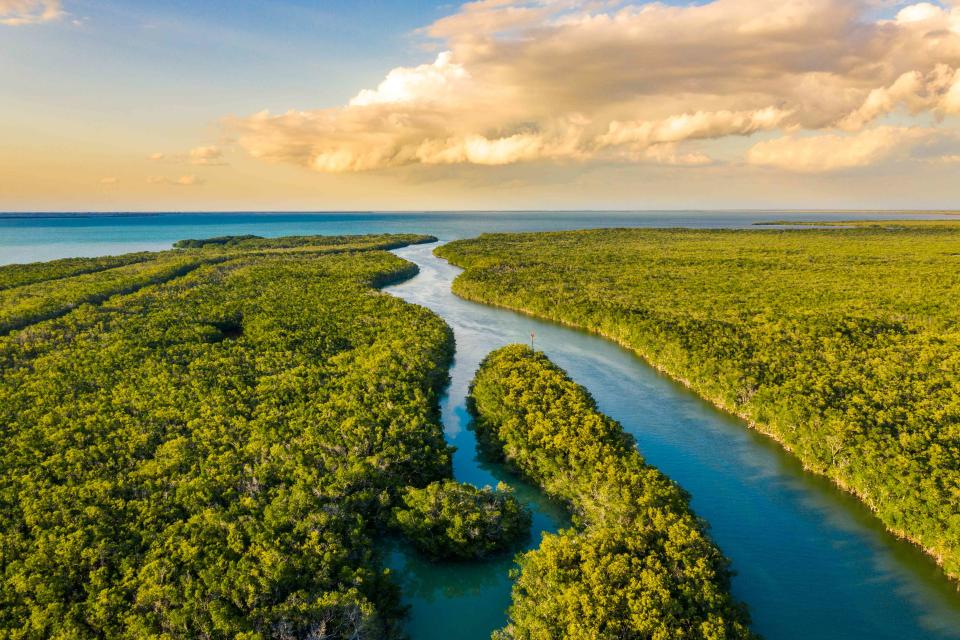
Getty Images
Flocks of white ibis roost in tangled mangroves. Marshmallow clouds reflect upon a blue bay. Expansive sawgrass prairies dance in the coastal wind. Welcome to Everglades National Park, the largest subtropical wilderness in the United States and largest wilderness area east of the Mississippi River. The park encompasses 1.5 million acres of diverse ecosystems and endless adventure in South Florida, about 20 percent of the original expanse of this slow-moving river.
Designated as a United Nations Educational, Scientific, and Cultural Organization (UNESCO) World Heritage Site, International Biosphere Reserve, and Wetland of International Importance, this national park attracts visitors from around the world for its unique landscape and ecological importance. In this guide, we’ll help you prepare for your next trip to Florida’s “River of Grass.”
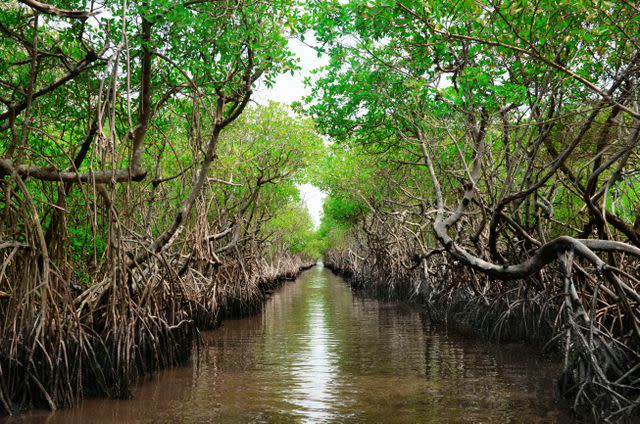
Getty Images
Entry Points and Visitor Centers
There are three entry points to Everglades National Park:
Everglades City (about 45 minutes from Naples) in the northwest
Miami in the northeast
Homestead (about 45 to 60 minutes from Miami) in the southeast
Due to the wetland terrain of the park, these three entrances are not connected. You won’t be able to enter the park in one region and drive through it to the others. Therefore, it’s best to pick one region per day to explore in depth.
All park visitors are required to pay an entrance fee, which ranges from $15 to $30. You can also use an interagency annual pass to enter. Visitor centers and entrance stations have set operating hours, but the park remains open 24/7.
Everglades City
The Everglades City end of the park hosts the Gulf Coast Visitor Center, though has been operating from temporary structures and hosting tabling events while the park repairs damages sustained from Hurricane Ian. As such, there are currently no set hours for the location.
Unlike the other two entry points, this end of the park has no formal fee collection booth or drive-through entrance. The region is best for those looking to explore the park on the water, offering an easy access boat ramp into Chokoloskee Bay.
Miami
The Miami entrance to the park hosts the Shark Valley Visitor Center, which is about a 45-minute drive from the Miami airport. It’s located along the relatively remote, two-lane Tamiami Trail (U.S. Highway 41) between Miami and Naples.
The visitor center operates daily from 9:00 a.m. to 6:00 p.m., with the parking gate and lot opening at 8:30 a.m. This region of the park is best for visitors wanting to explore on foot or bicycle.
Homestead
The Homestead entrance to the park hosts both the Ernest F. Coe Visitor Center and the Guy Bradley Visitor Center. This region of the park offers opportunities for exploring both on the water and by foot.
The Ernest F. Coe Visitor Center is located just after the park entrance. It includes a bookstore, educational displays, and park information. It operates from 9:00 a.m. to 5:00 p.m., April through mid-December, and 8:00 a.m. to 5:00 p.m., mid-December through March.
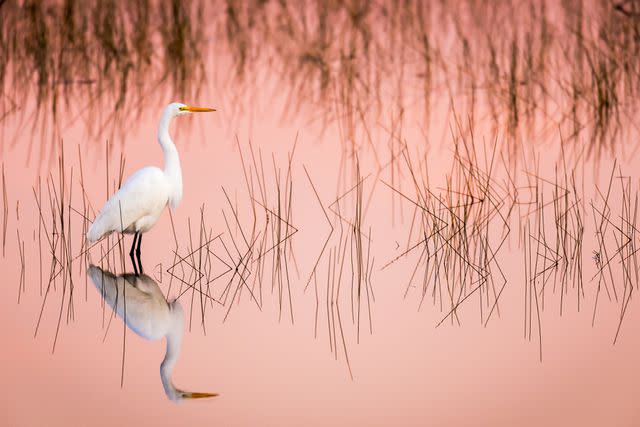
Getty Images
When to Visit
There are two seasons in Everglades National Park: wet and dry. Dry season typically occurs from December through April (winter/spring), while wet season stretches from May to November (summer/fall). While you can visit the park during either season, each has pros and cons.
Dry Season
Dry season sees little rainfall, relatively low humidity, and fewer biting insects like no-see-ums and mosquitoes. It offers a warm winter escape and is when the park sees its largest variety of birds. As areas of the park dry out during these months, hiking trails that might be flooded during the wet season can also be easier to navigate. However, since this is such a pleasant time to visit, you can expect to see more travelers and popular areas may experience crowding.
Wet Season
Wet season brings a lot of rain and thunderstorms, and its conditions create an influx of mosquitoes and other biting insects. There are also limited options for ranger-led programs during these months, though local guiding services continue to operate. While visiting the park in the rainy season has several downsides, it also provides fewer crowds and beautiful scenery as storms move across the landscape.
Where to Stay
There are plenty of places to stay close to Everglades National Park. Options range from primitive campsites to full-service hotels, depending on how close you’d like to be to the park and what amenities you prefer.
Camping
There are two frontcountry campgrounds in the southern end of the park for car camping, tent camping, or RV camping:
Long Pine Key Campground: This one is close to the Ernest F. Coe Visitor Center and Long Pine Key Trail. It’s open November 1 through April 30. Fees range from $33 to $60 per night. Amenities include bathhouses, a dump station, potable water, and cell phone service for AT&T and Verizon.
Flamingo Campground: This one is close to the Guy Bradley Visitor Center and Florida Bay. It’s open year-round, though portions close during the wet season. Fees range from $33 to $60 per night. Amenities include bathhouses, dump stations, picnic tables, grills, and an amphitheater for winter programs.
Park concessionaire Flamingo Adventures operates both campgrounds. You can learn more and reserve a campsite on their website. Flamingo Adventures also offers houseboats and eco-tents near the Flamingo Marina for a glamping experience in the park.
Other RV and car camping options can be found along the Tamiami Trail, such as Midway Campground, Monument Lake Campground, and Burns Lake Campground, all managed by Big Cypress National Preserve.
Kayakers and other boaters can also find primitive camping in the Everglades backcountry at one of its more than 40 ground, beach, and chickee wilderness sites. Backcountry campers must obtain a wilderness permit, which comes with a $21 fee plus $2 per person per night. Check the park’s website for critical information about planning a backcountry trip.
Lodging
The Flamingo Lodge is set to re-open in the park beginning November 2023. It was rebuilt after being destroyed by hurricanes Katrina and Wilma in 2005. Located at the southernmost tip of the Florida peninsula in the Homestead side of the park, the eco-conscious space offers private balconies with views of Florida Bay, Wi-Fi, kitchenettes, guided activities, a restaurant and bar, and more. Rates range from $159 to $399 per night. You can make a reservation on the Flamingo Adventures website.
There are also more traditional lodging options offered in the towns surrounding the park. Hoosville Hostel is a unique spot that’s convenient to the park’s Homestead entrance. Ivey House offers a perfect stay for exploring the Everglades City side of the park. Well-known hotel chains can be found in Naples, Miami, Homestead, and other nearby cities.
Where to Eat
Once in the park, your dining options are limited, so it’s best to pack a picnic for your day of exploring. However, you can find some snacks and beverages at the visitor centers and Flamingo Marina.
Homestead has a variety of restaurants available, such as Yardie Spice Jamaican & Haitian and White Lion Cafe. The Robert Is Here fruit stand is also worth a stop for its variety of tropical fruits, milkshakes, and local produce. It typically has a food truck in its picnic-area-meets-zoo behind the establishment.
Everglades City is also ripe with local dining options. Grab a tasty Cuban breakfast at HavAnnA Cafe and plan for fresh grouper tacos for dinner at Camellia Street Grill. Nely’s Corner and City Seafood are two other popular stops for breakfast or lunch, with the latter offering fresh stone crab straight from their boats.
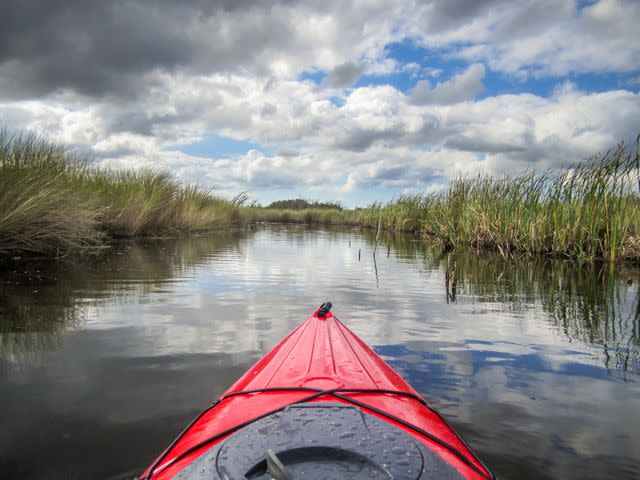
Getty Images
Explore by Water
Much of Everglades National Park is water, including vast bays, slow-moving channels through mangroves, and thick vegetation with swampy undersides. Getting on the water in the park is a great way to experience its landscape.
The Everglades City end of the park offers access to Chokoloskee Bay, the Ten Thousand Islands, and the Gulf of Mexico. The Sandfly Loop Paddling Trail is a popular one for kayaks and canoes in that area, as are the Halfway Creek and Turner River Canoe Trails.
The Homestead side of the park offers access to Florida Bay, the Buttonwood Canal, and Whitewater Bay. It has several popular paddling routes, such as Nine Mile Pond, Hell’s Bay, and Mud Lake Loop. You can learn more about each on the park’s website.
If it’s your first time in the park, know that navigation and conditions are tricky in the Everglades, even for experienced paddlers. There are several outfitters near both park entrances that offer guided tours, fishing trips, and kayak rentals, along with a wealth of knowledge worth soaking up for a safe adventure.
If you’re staying at Ivey House or Hoosville Hostel, both offer these services. You can also check out Everglades Florida Adventures in Everglades City and Flamingo Adventures on the Homestead side. In addition, Naples Fishing Adventures provides one-way water shuttles for you and your gear if you want to get deeper into the Everglades backcountry and paddle back to the Gulf Coast Visitor Center.
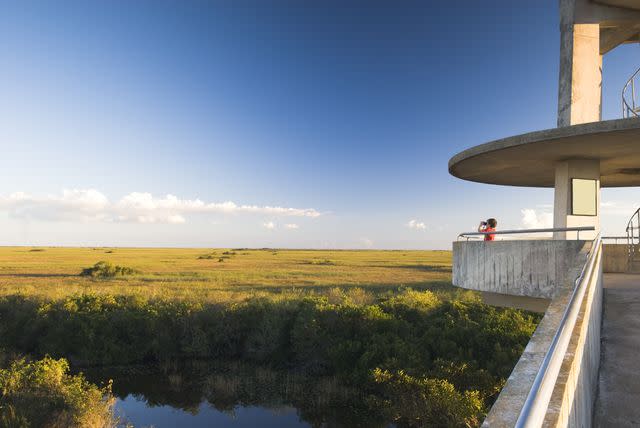
Getty Images
Explore by Land
If you’d like to stay on solid ground, Everglades National Park has options for hiking, biking, and tram tours to suit your needs. You can access these options from the Shark Valley Visitor Center and the Homestead entrance.
From the Shark Valley Visitor Center, you have access to a 15-mile paved trail to explore by bike, foot, or tram. The trail is excellent for wildlife viewing. You’ll also find panoramic views of sawgrass across the Shark River Slough from the trail’s accessible, 65-foot observation tower. There are bike rentals onsite for $23. The tram tour lasts about two hours and rates range from $15 to $29. You can reserve both in advance from Shark Valley Tram Tours, Inc.
The Homestead end of the park has some of the best boardwalks and hiking trails. The Gumbo Limbo Trail is a 0.4-mile paved loop through a shaded, jungle-like habitat of gumbo limbo trees, royal palms, and air plants. Right next door is the popular Anhinga Trail. This 0.8-mile hike follows a boardwalk through a sawgrass marsh. Expect to see a lot of wildlife, such as alligators, turtles, anhingas, herons, egrets, and many other birds.
You can find additional hiking trail options on the park’s website. From early December to late March, you can also explore the park’s HM69 Nike Missile Base, a preserved Cold War relic.
For More Information
To help with your trip planning, you can download the National Park Service mobile app, which includes interactive maps, tours of park places, on-the-ground accessibility information, and more park knowledge.
Also make sure to check the Everglades National Park website for the latest hours, services, and conditions in the park.
For more Southern Living news, make sure to sign up for our newsletter!
Read the original article on Southern Living.

